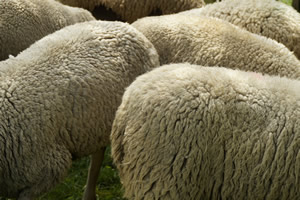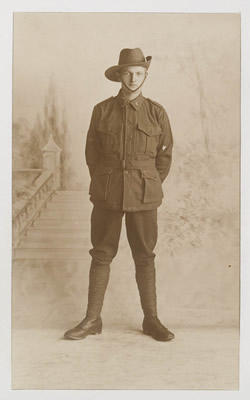Science and technology Stage 1
Overview

Sheep fleeces were used for vests for First World War soldiers, 2014
Students investigate the properties of various fabrics and materials used in soldiers’ uniforms in the First World War. They identify which fabrics and materials are most suited for particular purposes and explore the functionality of uniform items.
Teaching and learning activities

Henry Hastings, NSW Serviceman in uniform, 1918–1919
©Public domain (State Library of NSW)
What are the properties of clothing soldiers wore in the First World War and how was clothing used for particular purposes?
Question and predict
Discuss the function of clothing and the school uniform.
View images of the uniform worn by the First World War soldiers: The Australian Imperial Force (AIF) Other ranks uniform 1914–1918. Explain each item’s function.
Explain that the outer garments were made from Australian wool and that it was developed in consultation between medical and physiological advisers and officers of the Department of Defence for comfort, hygiene, free movement, circulation of air, protection and practicality.
Show students images of sheepskin vests worn by the Anzacs in the bitterly cold European winter of 1916–17. Discuss why the sheepskin vests were worn. Predict the properties of the vests.
Sources:
AWM P10550.493 — Portrait of an unidentified Australian soldier wearing a sheepskin vest...
AWM P10550.158 — Group portrait of four unidentified soldiers wearing sheepskin vests...
AWM REL33288 — Sheepskin vest with wool to inside
Investigate
Source from old clothing stores items of clothing or fabric made from cotton, flannel, wool and if possible, a piece of sheepskin (such as rug and ugg boots).
Students explore and record the thickness and texture of each fabric. They test each for strength (by cutting) and water resistance.
A demonstration test of the insulating properties of cotton, wool and sheepskin could also be undertaken, for example, The insulating properties of fabric
Do we use the same fabrics now? The tests could be repeated using contemporary fabrics used in the students’ school uniform.
Process and analyse data and information
Discuss the results from the investigation relating the properties of the fabrics to their use.
Students sort their results and indicate which fabrics are best for each purpose—warmth, water resistance, softness against the skin (undergarments), strength (durability).
Discuss how science was used in the development of the First World War soldiers’ uniform and to meet the needs of the coldest winter.
Communicate
Students label the uniform items and their properties on a photograph of an Australian First World War soldier wearing a uniform and sheepskin vest.
Students identify the properties of one item of the school uniform and explain why it is used for its particular purpose. They present this to the class.
Working Technologically
Redesign one piece of First World War uniform for warmth and explain changes.
Design and construct a sheepskin vest out of felt to fit a soft toy. Students need to consider sizing and ways to secure the vest.
Redesign or design a school uniform item for a particular purpose, for example, a winter school vest.
Learning concepts
These additional questions can be used for discussion or further investigations.
Challenge
The European winter of 1916/17 was the coldest for many years.
What was made and sent to the soldiers to keep them warm?
How did the properties of the material suit their purpose?
Change
With the change in weather to the coldest winter for at least ten years, additional items needed to be worn with the army uniform.
How were sheepskin vests produced and distributed to soldiers?
Digger’s Vest™ history and recreation
Caring
The Australian First World War AIF uniform was unique.
What properties of the fabrics suited their particular purposes in the uniform design?
What design features of the uniform helped care for our First World War soldiers?
The Australian Imperial Force (AIF) Other ranks uniform 1914–1918
Community
Sewing groups across Australia made sheepskin vests. It was an example of the strong community spirit in Australia in supporting our soldiers.
How could the design of the vests be kept consistent?
What features on the vest enabled them to be worn by different sized soldiers?
Commemoration
To commemorate the centenary of Anzacs a sheepskin factory is making reproduction Digger’s Vest™.
Why would sheepskin vests be worn by people today?
Syllabus links
ST1-4WS investigates questions and predictions by collecting and recording data, sharing and reflecting on their experiences and comparing what they and others know.
ST1-13MW relates the properties of common materials to their use for particular purposes
Working scientifically
Students question and predict by:
-
making predictions about familiar objects and events and the outcomes of investigations (ACSIS024, ACSIS037, ACSHE021, ACSHE034)
Students plan investigations by:
-
identifying the purpose of the investigation
-
recognising that the results of investigations can inform the processes of Working Technologically
Students conduct investigations by:
-
working cooperatively and individually when participating in different types of guided investigations to explore and answer questions, such as manipulating materials, testing ideas, and accessing information sources, surveys and fieldwork (ACSIS025, ACSIS038)
-
using a range of methods to gather data and/or information, including using their senses to make observations safely and carefully, using simple tools and equipment
Students process and analyse data and information by:
-
using a range of methods to sort information, including drawings and provided tables, to match objects and events based on easily observable characteristics (ACSIS027, ACSIS040)
-
comparing observations with predictions through discussion, as to whether observations were expected and related to their questions and/or predictions (ACSIS212, ACSIS214)
Students communicate by:
-
representing and communicating observations and ideas using oral and written language, drawing and role-play (ACSIS029, ACSIS042)
Material world
Students:
-
use their senses to identify the similarities and differences in the properties of materials, eg the textures of different fabrics, the difference in hardness of solid materials and the runniness of different liquids
-
identify the properties of some common materials and why they are used for particular purposes, eg the waterproof property of plastic rainwear or insulating property of a woollen jumper